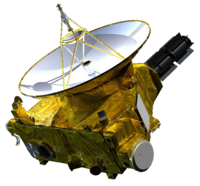
Photo from wikipedia
We propose an optical clock based on narrow, spin-forbidden M1 and E2 transitions in laser-cooled neutral titanium. These transitions exhibit much smaller black body radiation shifts than those in alkaline… Click to show full abstract
We propose an optical clock based on narrow, spin-forbidden M1 and E2 transitions in laser-cooled neutral titanium. These transitions exhibit much smaller black body radiation shifts than those in alkaline earth atoms, small quadratic Zeeman shifts, and have wavelengths in the S, C, and L-bands of fiber-optic telecommunication standards, allowing for integration with robust laser technology. We calculate lifetimes; transition matrix elements; dynamic scalar, vector, and tensor polarizabilities; and black body radiation shifts of the clock transitions using a high-precision relativistic hybrid method that combines a configuration interaction and coupled cluster approaches. We also calculate the line strengths and branching ratios of the transitions used for laser cooling. To identify magic trapping wavelengths, we have completed the largest-to-date direct dynamical polarizability calculations. Finally, we identify new challenges that arise in precision measurements due to magnetic dipole-dipole interactions and describe an approach to overcome them. Direct access to a telecommunications-band atomic frequency standard will aid the deployment of optical clock networks and clock comparisons over long distances.
Journal Title: Physical Review A
Year Published: 2023
Link to full text (if available)
Share on Social Media: Sign Up to like & get
recommendations!